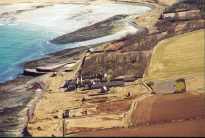|
Access For All at Caithness Castlehill Flagstone Trail
17 February 03
The repair has been enabled by the award of �30,000 funding from the Aggregates Levy Grant Fund. The works will improve the path with the use of natural materials, and especially flagstone, given the focus of the trail. Unfortunately, due to the excavations required for repair to take place, and the large area this will cover, the trail will be closed to the public from today, 17th February for an anticipated month to ensure public safety.
Castletown Heritage Society helped set up the trail and
has become a popular visitor attraction. The heyday of the flagstone industry in Castletown was from 1814 to 1914. After this time the depression and the increasing use of concrete led to the closure of the works and the scrapping of the machines. At its peak the flagstone works and quarries in Castletown employed over 500 people. Flagstone workers built the original part of the village of Castletown as they were allowed to take home single faced stone with which to build a house. Many of these houses still stand today to the South of the main street. All but one of the local quarries, of which there were six, have been filled in over the years. The only working quarries in Caithness are located on the West side of the county near Halkirk and beside Spittal. They employ around 30 people each and are undergoing a recovery at the moment with architects keen to use natural materials in their works. See Pictures Of A Working Quarry -
A & D Sutherland At Spittal Flagstone Village Price �14.95 Our book is now available from bookshops and newsagents and selected
post offices across the county.
|

 Book
Out
Book
Out